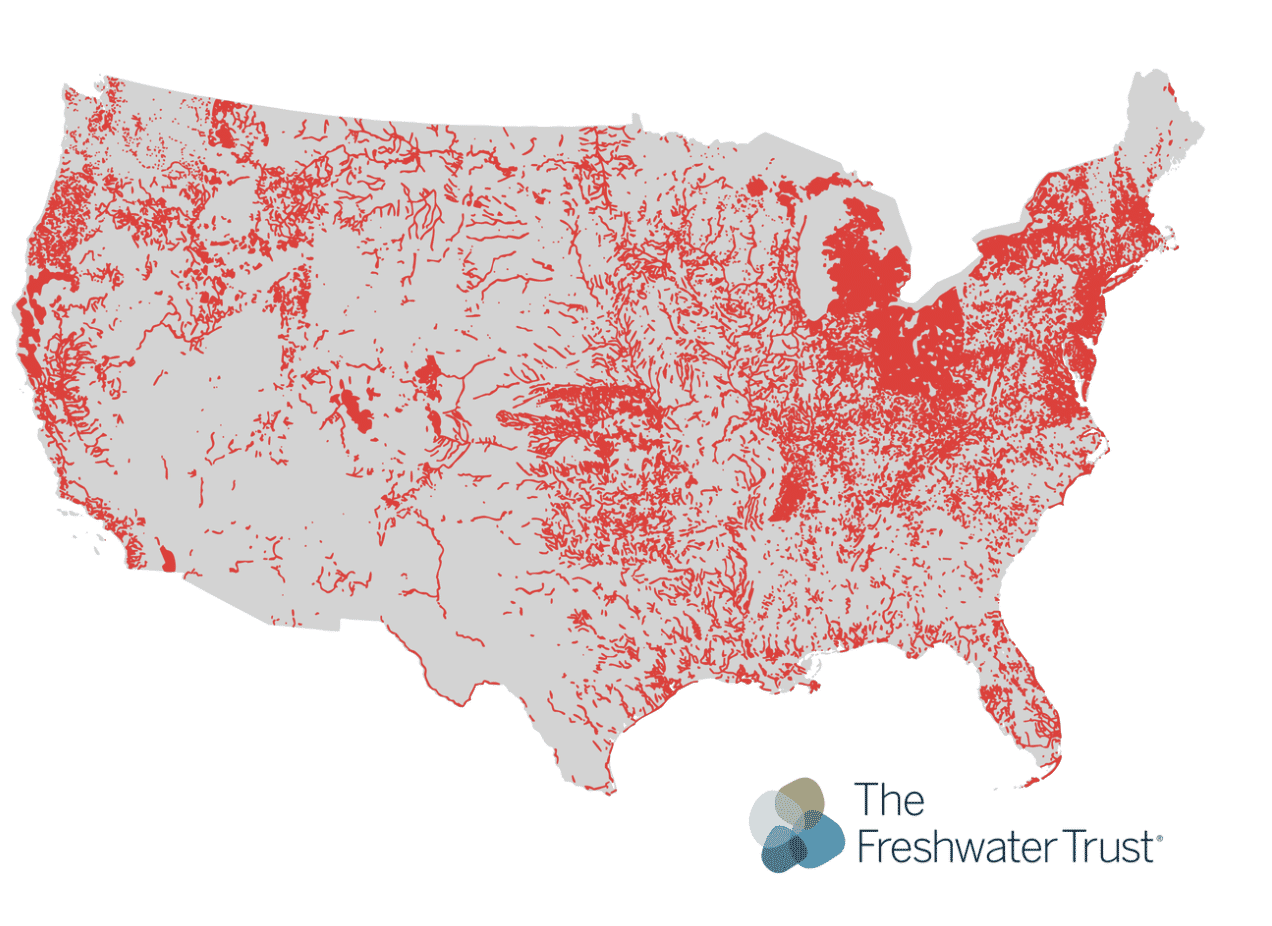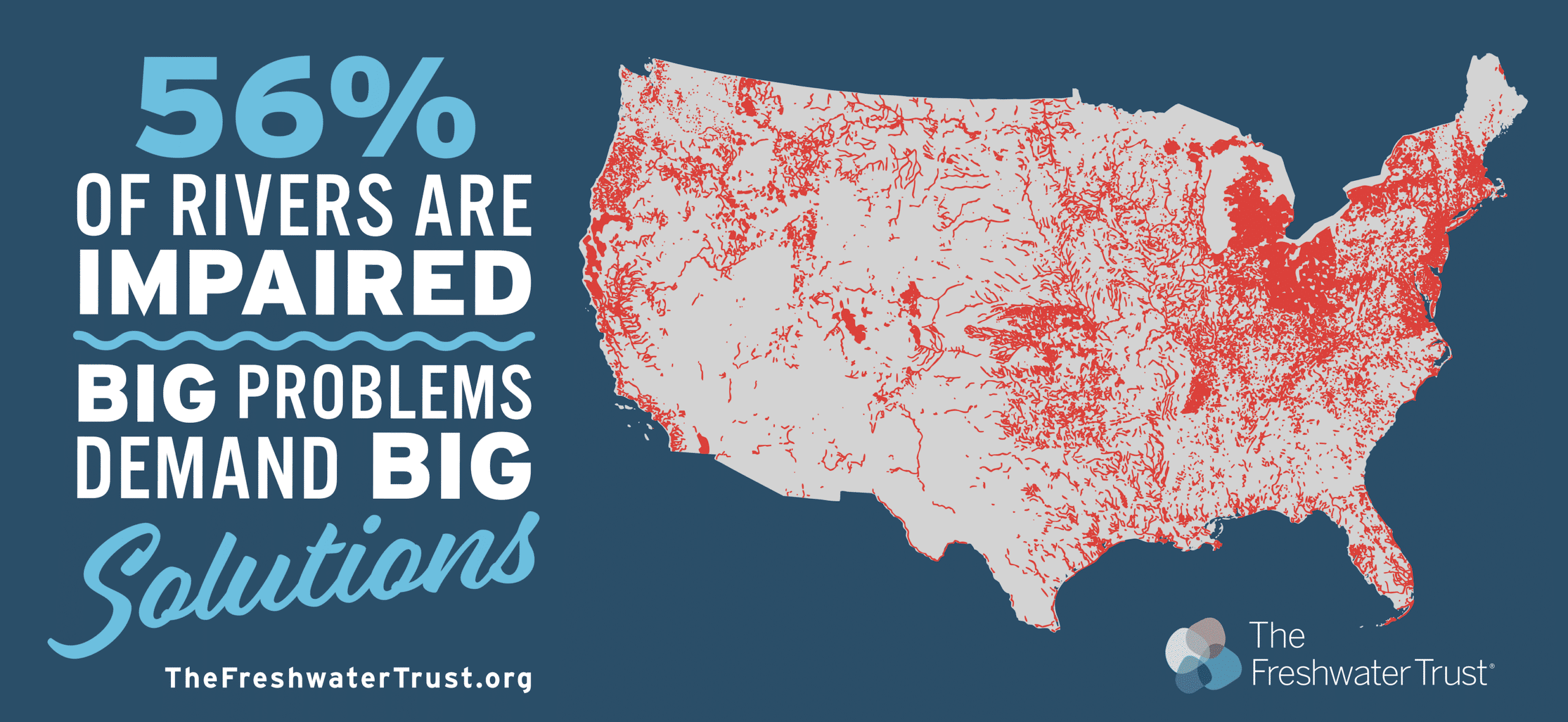All of these waters are impaired. Really.
The first draft of my book “Quantified” had a chapter titled, “The Problem.” Under that header, there was one sentence, “There is one. Enough said.” It didn’t fly with my editors.
They reminded me that few have spent the past two decades following and witnessing the ways rivers are impaired and why that should matter. In order for the solution I was proposing to be powerful and persuasive, I had to explain the vast and systemic nature of the issues. Right now,
- 56% OF AMERICA’S RIVERS ARE IMPAIRED UNDER THE CLEAN WATER ACT.
- 24% OF ALL RIVERS AND STREAMS SUFFER FROM DEGRADED LAND AROUND THEM.
- 40% OF MAJOR OREGON RIVERS HAVE BEEN MODIFIED FROM THEIR NATURAL STATE.
- THE U.S. SPENDS $20 BILLION ON FRESHWATER HEALTH AND RESTORATION EVERY YEAR.

Together, these facts tell a powerful story: The issue is bigger than imagined and growing. We are spending billions on a problem and not making a dent. Something has to change, and The Freshwater Trust (TFT) is leading the way.
With innovative partnerships, highly leveraged funding models, and new technologies, TFT is bringing solutions to the table that can tackle all of the above.
With your help, we can bring widespread attention to the scope of the problems our rivers face and raise the funds to fix them.
By the end of June, our goal is to bring awareness to the problem by highlighting facts like the ones above on billboards in several major Western cities. Then, our second goal is to implement projects that address the problems themselves – reducing nutrient pollution, increasing water quantity, restoring fish habitat, and activating systems that ensure money spent on restoration and conservation is money spent effectively and efficiently. Check out the design for the billboard at the bottom of this letter.
Will you make a contribution of $50, $100 or $250 today?
All of the red lines on this map are the impaired rivers and streams across the country. In Oregon, that’s 10,759 miles. In California, it’s 23,240 miles. This means that under the Clean Water Act, these rivers aren’t fishable, swimmable, or drinkable.
If a picture says a thousand words, this one is a novel. I hope it speaks to you. With your help, it can speak to thousands more.
But highlighting a problem without a solution doesn’t fix anything – and TFT is in the business of fixing rivers.
We have always been solutions focused and forward. We know what needs to be done to reduce the number of red rivers on this map. Your support increases the pace and scale with which we are able to do that.
Please consider making a gift before on-the-ground restoration season officially begins on June 1.
Here’s what we have planned:
- DOZENS OF NEW LARGE WOOD PROJECTS IN THE SANDY BASIN THAT WILL IMPROVE NATIVE FISH HABITAT AND WATER QUALITY
- 10 NEW REVEGETATION PROJECTS IN THE ROGUE TO RESTORE FISH HABITAT, FILTER NUTRIENTS, PREVENT BANK EROSION, AND CREATE SHADE
- 17 FLOW DEALS PROTECTING 17,500 GALLONS PER MINUTE IN THE JOHN DAY
- 5 NEW MODELS REFINED TO ENSURE THAT ANY RESTORATION OR CONSERVATION PROJECT IS PRIORITIZED AND QUANTIFIED
The issues impairing our rivers are not inexplicable or insurmountable, and TFT has 30 years of experience and trackable results. That’s the good news. Now we need your help to get after it at the pace and scale that will ensure these rivers are repaired on a timeline that matters for us and for those who will come after.
Thank you for being with us.
Joe Whitworth
President
P.S. You look at this map and might say that changing all that red to blue isn’t possible. But everyday, the staff at TFT are building, innovating, tracking, and doing – with your support. Please make a gift to help us raise awareness about what’s wrong with our rivers and employ straight forward, impactful solutions for fixing them.

Enjoying Streamside?
This is a space of insight and commentary on how people, business, data and technology shape and impact the world of water. Subscribe and stay up-to-date.
Subscribe- Year in Review: 2023 Highlights
By Ben Wyatt - Report: Leveraging Analytics & Funding for Restoration
By Joe Whitworth - Report: Transparency & Transformational Change
By Joe Whitworth - On-the-Ground Action – Made Possible By You
By Haley Walker - A Report Representing Momentum
By Joe Whitworth

